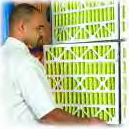Proper filter maintenance is crucial to keeping HVAC ductwork clean. If dirt accumulates in the ductwork, and if the relative humidity reaches the dew point (so that condensation occurs), then bacteria and mold may grow. This is especially the case in HVAC systems with acoustical duct liners, which are frequently used in air handler fan housings and supply ducts to reduce sound transmission and provide thermal insulation.
For all of these reasons and more, it is crucial to establish the appropriate filter change-out frequency. However, filters should be changed immediately if they become wet, microbial growth on the filter media is visible, or when filters collapse or become damaged to the extent that air bypasses the media.

FILTER INSTALLATION
After specifying a filter media and selecting a filter, it’s important to pay close attention to proper filter installation. The goal is to avoid bypass air, which causes contamination in housings, coils, fans, and ducts. Do this by making sure that all the air in the system goes through the filter. To avoid problems later on, consider these installation tips:- Check for filter media damage such as rips or holes and replace damaged filters.
- Make sure media is sealed in the frame to avoid bypass air.
- Install the filter according to the airflow direction indicated on the frame.
- Ensure that the filter fasteners are in place and correctly installed, especially if filters are serviced from the downstream side.
- Check to ensure that the bank of filter frames is rigid and well reinforced to avoid collapse.
- Caulk any cracks between filter frames or between the bank of frames and the duct wall to prevent leaking of unfiltered air.
- Pay special attention to filter holding frame seals, gaskets, and filters that don’t match the filter holding frame size - all of which can cause bypass air.

FILTER MONITORING
After filters are installed and operating, they should be monitored and maintained to provide maximum filtration, while not overtaxing the supply fan capability or leading to “blow-out” situations with no air filtration. Scheduled maintenance or established pressure drops can be determining factors, along with specific variations in environmental conditions such as humidity and seasonal changes.A differential pressure measurement device can be installed across the filter bank to identify the appropriate change-out times. Pressure drop switches may be used to provide an alarm input to a building automation system that alerts operators to change the filter. Don’t rely on a visual inspection only, since medium- and high-efficiency filters that appear “dirty” often have not reached their optimum efficiency levels. In addition, normal eyesight can only see particles of about 40 microns in size. Therefore, a filter rated at 10 microns can look dirty, yet still have a useful service life.
As a filter loads up with particles, it becomes more efficient at particle removal, but increases pressure drop through the system, thus reducing airflow. All filters - if loaded to excess - will become deformed, unload dust, and even “blow out” of their filter rack. When filters blow out, bypassing of unfiltered air will lead to clogged coils and dirty air ducts. Flow capabilities of the system fan may also be affected. Filters also should be monitored for bacterial growth. It’s a good idea to remove selected filter elements periodically and send them to a lab for testing when bacterial growth is found.
MAKE THE JOB EASY
Some filter manufacturers use a two-color filter media construction to help in installation by making it easy to see, for example, that the gold side faces upstream, while the white side faces downstream.Another tip filter suppliers recommend for making the job of changing filters easier is to place labels on the housing units with information such as the number and type of filters, date changed, and pressure drop. Air handlers that are located in difficult-to-access places will be more likely to suffer from poor air filter maintenance and overall poor maintenance. Therefore, quick release and hinged access doors for maintenance are more desirable than bolted access panels when security is not an issue.
CHECK THE DETAILS
When changing the filter, make sure that the replacement filter is the correct size and compatible with your housing. Review the performance value of the filter to ensure the pressure drop across the filter will not be too great, especially as the filter loads. The greater resistance will reduce the airflow to the unit, creating a negative impact on the unit’s heating/cooling efficiency and energy efficiency.PROTECT THE HVAC SYSTEM AND OCCUPANTS
If schedules allow, time filter change-outs so they occur when the facility is unoccupied. This will help to avoid problems associated with disruptions in the HVAC system and possible distribution of odors or emissions that may occur.In some facilities, it’s nearly impossible to time filter change-outs so they occur when the facility is unoccupied. It is therefore critical to turn off the supply fans to prevent debris from entering the ductwork downstream of the filters. Similarly, the entire filter area should be cleaned and washed down while fans are off. Use a clean rag instead of compressed air to wipe dust from the inside of the filter housing and around gasket surfaces. When removing a spent filter, take care to avoid dropping contaminants in the ductwork.
FINAL ADVICE
At the end of the day, it is important to follow the recommendations of the filter and the HVAC system manufacturer/supplier to determine the proper procedures and frequencies for maintaining and changing filters. And don’t forget to fully document all inspections and corrective actions.Reprinted with permission from the Kimberly-Clark Filtration Products publicationFiltering Out Confusion – A Guide to Understanding HVAC Filter Maintenance.For more information on HVAC filters, visit www.kcfiltration.com or e-mail filtration_media@kcc.com.
Publication date:12/11/2006

Report Abusive Comment